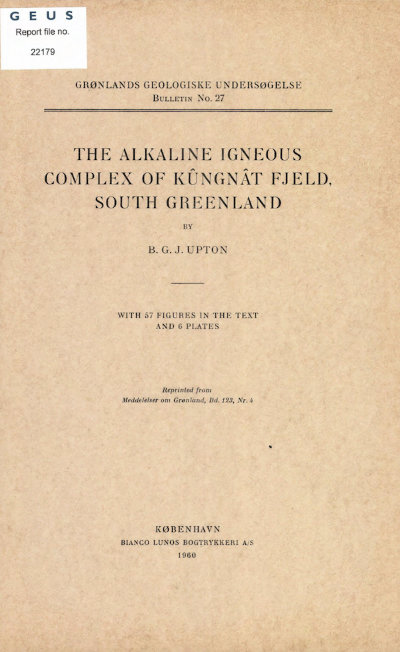The alkaline igneous complex of Kûngnât Fjeld, South Greenland
DOI:
https://doi.org/10.34194/bullggu.v27.6560Abstract
An intrusive complex of saturated syenites and gabbros near Ivigtut in S.W. Greenland forms the mountain of Kûngnât Fjeld. The rocks were intruded into the basement gneisses towards the close of the Gardar period, thought to be of Pre-Cambrian age. The complex consists of three steep-sided syenite bodies. These were intruded successively with progressive easterly shift of centre and were succeeded by an alkali gabbro intrusion which, occurring as a ring-dyke, almost entirely surrounds the syenites. Emplacement of each of these intrusions is thought to have been by ring-faulting and cauldron subsidence. The S.W. marginal syenite, regarded as the earliest of the three syenite intrusions, is a small, poorly exposed body. It consists of quartz syenite containing fayalite and aegirine-augite. The second syenite intrusion formed the western layered syenite stock. This is a larger mass thought to have been originally ca. 2.6 X 3.5 kms. It possesses the characteristics of a layered intrusion of Skærgaard type with inwardly directed rhythmic banding, cryptic layering, feldspar lamination and an overall increase in mafic index from top to bottom. The base of the layered rocks is not exposed. The intrusion is divided horizontally, by a raft-like mass of gneiss blocks, into an upper and a lower layered series. This raft, the "grey-zone", is believed to represent a subsided mass of roofing material which sank only a relatively short distance before coming to rest, suspended in the magma chamber. Differentiation by bottom accumulation of fayalite, clinopyroxene, high-temperature alkali feldspars etc. continued independently above and below this raft. In each case it resulted in pronounced fractionation of the magma. In both series the rocks grade up from quartz-free to quartz-bearing types. The ultimate differentiates of the upper layered series have been lost by erosion, but those of the lower series are represented by transgressive soda-granite dykes and sheets. These latter, which remained unconsolidated until very late in the cooling history of the complex, include riebeckite-astrophyllite granites of close affinity to some of the Nigerian examples. The differentiated sequence of the lower layered series is analogous to the larvikite-nordmarkite-ekerite sequence of the Oslo region. The eastern syenite intrusion is also layered in its central part with somewhat higher average dips than in the western intrusion. For the most part it consists of more basic syenites with more magnesian pyroxenes and olivines and more calcic feldspars. However, fractionation in situ again produced quartz syenites of less basic type. The eastern stock possesses a marginal border group on its eastern flanks. An irregular zone of pegmatite surrounds the eastern intrusion and is thought to have been caused by outward diffusion of volatiles and alkali silicates. In the syenites partial analyses indicate a range in feldspar composition from Ab59 Or29 An10·5 Cn1·5 to ca. Ab59 Or37·5 An3·5, (mol. comp.). Optical data show a pyroxene range from augites of ca. Ca42 Mg20 Fe38 through ferroaugites to hedenbergitic types, and with progressive Na enrichment through to aegirine-augites. The olivines range from ca. Fa80-Fa100. Convection, occurring within the main western and eastern syenite magma chambers, is believed to have been responsible for the steep inclination of the layering by promoting marginal deposition of primary precipitate crystals. Evidence for strong magmatic currents is mainly provided by the trough-banding. Consideration of the feldspars suggests that in the two layered intrusions the magma chambers became filled with accumulated crystal mush over. a temperature range between 800-700°C. The behaviour of the trace-elements is broadly similar to that found in the Skærgaard series, except that at Kûngnât Ba and Sr were progressively removed from the magma. Li and Zr are strongly concentrated in the latest fractionates of the western lower layered series. The syenite melts were continuously depleted in F by the bottom accumulation of fluorapatite. The ring-dyke consists of a suite of gabbroic and syeno-gabbroic rocks thought to have been derived by the fractionation of alkali-basalt magma at depth. Some contamination by syenitic material is suspected. In places the ring-dyke rocks suffered strong metasomatism from residual syenitic and granitic liquids. Apart from water, this alteration involved the addition of Li and Rb. Spectrographic analyses of the feldspars from the whole complex showed that there are all gradations from those with severe Rb depletion to those with moderate Rb enrichment. A surprising Ag-Cu content in some of the feldspars is attributed to the presence of submicroscopic sulphide inclusions. The four Kûngnât intrusions were apparently intruded in order of increasing basicity. A possible explanation is that the four magma portions were tapped off from successively deeper levels of an already differentiated parental magma. The Kûngnât complex is probably coeval and comagmatic with the alkaline intrusions at Nunarssuit, Ilímaussaq and Tugtutôq. The development of nepheline syenites in this region of south Greenland is considered to be closely linked to that of the saturated syenites such as those at Kûngnât.
Downloads
Published
Issue
Section
License
This article is distributed under a CC-BY 4.0 licence, permitting free redistribution and reproduction for any purpose, even commercial, provided proper citation of the original work. Author(s) retain copyright over the article contents.


